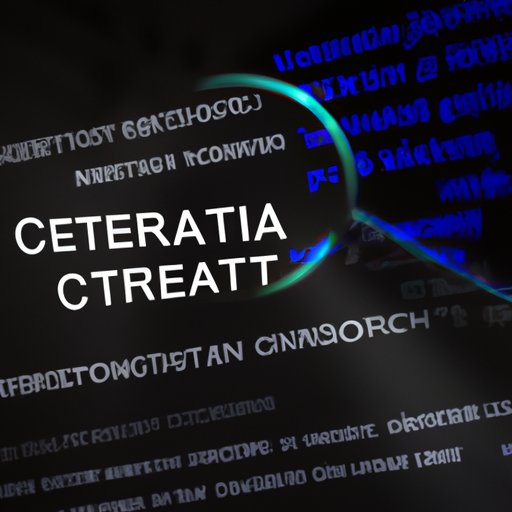Introduction
Technology has become an integral part of our lives. It has allowed us to connect with people from all over the world, streamline our work processes, and access unprecedented amounts of information. However, technology can also be dangerous if not used responsibly. In this article, we will explore the potential dangers of technology, including cybercrime, automation, social media, excessive screen time, and artificial intelligence, as well as strategies to mitigate these risks.

Exploring the Potential for Cybercrime and Data Breaches
Cybercrime is a term used to describe any criminal activity that involves computers or networks, such as hacking, fraud, identity theft, and data breaches. Data breaches are when an unauthorized party gains access to sensitive information, resulting in the potential for identity theft and financial loss. According to a study by Experian, more than half of U.S. businesses experienced a data breach in 2019, with the average cost per breach estimated at $4 million.
Common types of cybercrime and data breaches include phishing, malware, ransomware, and denial of service attacks. Phishing is when an attacker sends a malicious email or text message in an attempt to gain access to your personal information. Malware is malicious software used to infect computers and networks with the intent of stealing data or disrupting operations. Ransomware is a type of malware that encrypts files and requires a ransom payment in exchange for the decryption key. Finally, denial of service attacks are when an attacker floods a server with requests, making it inaccessible.
To prevent cybercrime and data breaches, it is important to practice good security habits, such as using strong passwords and two-factor authentication, avoiding suspicious links, and regularly updating software and antivirus programs. Additionally, businesses should invest in security measures such as firewalls, encryption, and regular system audits.
Unintended Consequences of Automation
Automation is the use of technology to automate processes and tasks, such as manufacturing, customer service, and data entry. While automation can reduce costs and increase efficiency, it can also have unintended consequences. According to a report from McKinsey Global Institute, up to 375 million workers—or 14 percent of the global workforce—may need to switch occupations by 2030 due to automation.
The impact of automation on jobs and industries varies widely depending on the industry, with some industries being more affected than others. For example, automation has had a significant impact on the manufacturing industry, as many manual labor jobs have been replaced by robots. Similarly, automation has had an impact on the customer service industry, as many companies are now using automated chatbots to handle routine customer inquiries.
To mitigate the negative impacts of automation, businesses should focus on retraining and upskilling their current workforce. Additionally, governments should provide incentives for businesses to invest in workforce development initiatives, such as job training programs and apprenticeships.

The Impact of Social Media on Mental Health
Social media is a platform where users can share photos, videos, and messages with friends and family. While social media can be a great way to stay connected, it can also have negative impacts on mental health. According to a study published in the Journal of Social and Clinical Psychology, heavy social media use is associated with increased levels of depression and anxiety.
Negative impacts of social media on mental health can include feeling inadequate compared to others, experiencing FOMO (fear of missing out), and developing unhealthy relationships with technology. Additionally, spending too much time on social media can lead to feelings of isolation and disconnection from real life.
To manage social media use, it is important to set boundaries and limit the amount of time spent on platforms. Additionally, users should be mindful of what they post and avoid comparing themselves to others. Finally, it is important to take breaks from social media and engage in activities that promote self-care and connection with others.
The Negative Effects of Excessive Screen Time
Excessive screen time is defined as spending too much time on devices such as phones, tablets, computers, and televisions. According to a study by Common Sense Media, the average child spends more than seven hours a day looking at screens.
Some of the negative impacts of excessive screen time include sleep disruption, poor physical health, and difficulty concentrating. Additionally, too much time on devices can lead to an increase in anxiety and depression, as well as social isolation. Finally, it can also interfere with relationships, as it can be difficult to connect with others when constantly distracted by screens.
To reduce screen time, it is important to establish rules and limits for device use. Additionally, it is important to create screen-free zones in the home, such as bedrooms and dining rooms. Finally, it is important to find other activities to do, such as reading books, playing board games, and going outside.
Dangers of Artificial Intelligence
Artificial intelligence (AI) is a form of technology that enables machines to think and learn like humans. While AI can be beneficial in many ways, such as improving healthcare and automating tedious tasks, it can also be dangerous if not used responsibly. According to a study by the International Bar Association, AI can pose a risk to human rights, privacy, and safety.
Potential risks of AI include bias, privacy violations, and autonomous weapons. AI systems can be biased if they are not programmed properly, resulting in decisions that may be unfair or discriminatory. Additionally, AI systems can violate user privacy if used to track people without their knowledge or consent. Finally, autonomous weapons, such as drones and robot soldiers, can cause significant harm if used incorrectly.
To mitigate the risks of AI, it is important to ensure that AI systems are programmed ethically and transparently. Additionally, governments should regulate the use of AI and implement policies to protect user privacy. Finally, businesses should invest in responsible AI initiatives, such as diversity and inclusion initiatives.
Conclusion
In conclusion, technology can be dangerous if not used responsibly. This article explored the potential dangers of technology, including cybercrime, automation, social media, excessive screen time, and artificial intelligence, as well as strategies to mitigate these risks. It is important to practice good security habits, such as using strong passwords and two-factor authentication, to prevent cybercrime and data breaches. Additionally, businesses should focus on retraining and upskilling their current workforce to mitigate the negative impacts of automation. Finally, it is important to set boundaries and limits for device use and find other activities to do in order to reduce screen time. By taking the necessary steps to mitigate these risks, we can ensure that technology is used safely and responsibly.
(Note: Is this article not meeting your expectations? Do you have knowledge or insights to share? Unlock new opportunities and expand your reach by joining our authors team. Click Registration to join us and share your expertise with our readers.)
